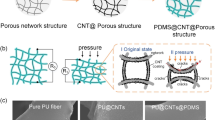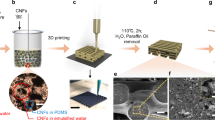Abstract
Flexible wearable pressure sensors with high sensitivity have a wide range of applications in the field of healthcare monitoring, e-skin technology, robotic limbs, and other human–machine interaction under low pressures. For very low pressures, a sensor with high sensitivity and bulky, expensive measuring equipment is required to obtain the output signal. The incorporation of a micro-pyramidal porous dielectric section can considerably enhance the sensitivity of the capacitance-based pressure sensor. This article has employed a finite element method-based three-dimensional simulation to assess the performance of the porous microstructured capacitive pressure sensor (pmcps). The numerical results revealed a high level of agreement with the experimental data. To simplify the design and fabrication of the sensor with optimal performance, the effects of parameters such as sensor dielectric constant, dielectric layer porosity, base length, tip width, height, and inter-microstructural spacing of porous micro-pyramids were investigated using the response surface methodology. Sensitivity analysis showed that the tip width of the micro-pyramid has the greatest effect on sensor sensitivity and the least effect on the initial capacitance. Finally, equations were proposed for predicting the initial capacitance and sensor sensitivity based on the geometric parameters of the porous micro-pyramid and intrinsic properties of the dielectric section using three-dimensional finite element simulation to facilitate the ability to predict the fabrication and design process of the pmcps and optimize its performance for different applications.








Similar content being viewed by others
Data availability
Enquiries about data availability should be directed to the authors.
References
Zang, Y., Zhang, F., Di, C.A., Zhu, D.: Advances of flexible pressure sensors toward artificial intelligence and health care applications. Mater. Horizons 2(2), 140–156 (2015). https://doi.org/10.1039/C4MH00147H
Takaloo, S., Zand, M.M., Kalantar, M., & Rezayan, A.H. (2023). Detection of c-reactive protein using a flexible biosensor with improved bending life. J. Electrochem. Soc. 170(5), 057513. https://doi.org/10.1021/ACSAMI.6B05177/SUPPL_FILE/AM6B05177_SI_001.PDF
Takaloo, S., Zand, M.M.: Wearable electrochemical flexible biosensors: with the focus on affinity biosensors. Sens. Bio-Sens. Res 32, 100403 (2021)
Chang, W.-Y., Fang, T.-H., Yeh, S.-H., Lin, Y.-C.: Flexible electronics sensors for tactile multi-touching. Sensors 9(2), 1188–1203 (2009). https://doi.org/10.3390/S9021188
Yang, Y., et al.: Human skin based triboelectric nanogenerators for harvesting biomechanical energy and as self-powered active tactile sensor system. ACS Nano 7(10), 9213–9222 (2013). https://doi.org/10.1021/NN403838Y/SUPPL_FILE/NN403838Y_SI_004.AVI
Zhu, G., et al.: Self-powered, ultrasensitive, flexible tactile sensors based on contact electrification. Nano Lett. Lett. 14(6), 3208–3213 (2014). https://doi.org/10.1021/NL5005652/SUPPL_FILE/NL5005652_SI_005.AVI
Tang, X., et al.: Multilevel microstructured flexible pressure sensors with ultrahigh sensitivity and ultrawide pressure range for versatile electronic skins. Small 15(10), 1804559 (2019). https://doi.org/10.1002/SMLL.201804559
Ruth, S.R.A., et al.: Rational design of capacitive pressure sensors based on pyramidal microstructures for specialized monitoring of biosignals. Adv. Funct. Mater.Funct. Mater. 30(29), 1903100 (2020)
Duan, Y., He, S., Wu, J., Su, B., Wang, Y.: Recent progress in flexible pressure sensor arrays. Nanomater 12(14), 2495 (2022). https://doi.org/10.3390/NANO12142495
Kaiqiang, W., Xingyang, L.: Wearable pressure sensor for athletes’ full-range motion signal monitoring. Mater. Res. Express 7(10), 105003 (2020). https://doi.org/10.1088/2053-1591/ABBBCC
Zhang, Y., et al.: Highly stable flexible pressure sensors with a quasi-homogeneous composition and interlinked interfaces. Nat. Commun.Commun. 13(1), 1–12 (2022). https://doi.org/10.1038/s41467-022-29093-y
Zhang, J.W., Zhang, Y., Li, Y.Y., Wang, P.: Textile-based flexible pressure sensors: a review. Polym. Rev.. Rev. 62(1), 65–94 (2021). https://doi.org/10.1080/15583724.2021.1901737
Jung, S., et al.: Reverse-micelle-induced porous pressure-sensitive rubber for wearable human-machine interfaces. Adv. Mater. 26(28), 4825–4830 (2014). https://doi.org/10.1002/ADMA.201401364
Pizarro, F., Villavicencio, P., Yunge, D., Rodríguez, M., Hermosilla, G., Leiva, A.: Easy-to-build textile pressure sensor. Sensors 18(4), 1190 (2018). https://doi.org/10.3390/S18041190
Xu, F., et al.: Recent developments for flexible pressure sensors: a review. Micromachines 9(11), 580 (2018). https://doi.org/10.3390/MI9110580
Lee, J., et al.: Conductive fiber-based ultrasensitive textile pressure sensor for wearable electronics. Adv. Mater. 27(15), 2433–2439 (2015). https://doi.org/10.1002/ADMA.201500009
Yang, J., et al.: Flexible, tunable, and ultrasensitive capacitive pressure sensor with microconformal graphene electrodes. ACS Appl. Mater. Interfaces 11(16), 14997–15006 (2019). https://doi.org/10.1021/ACSAMI.9B02049/SUPPL_FILE/AM9B02049_SI_001.PDF
Ramuz, M., Tee, B.C.K., Tok, J.B.H., Bao, Z.: Transparent, optical, pressure-sensitive artificial skin for large-area stretchable electronics. Adv. Mater. 24(24), 3223–3227 (2012). https://doi.org/10.1002/ADMA.201200523
Matsouka, D., Vassiliadis, S., Bayramol, D.V.: Piezoelectric textile fibres for wearable energy harvesting systems. Mater. Res. Express 5(6), 065508 (2018). https://doi.org/10.1088/2053-1591/AAC928
Li, J., Bao, R., Tao, J., Peng, Y., Pan, C.: Recent progress in flexible pressure sensor arrays: from design to applications. J. Mater. Chem. C 6(44), 11878–11892 (2018). https://doi.org/10.1039/C8TC02946F
Lei, K.F., Lee, K.F., Lee, M.Y.: Development of a flexible PDMS capacitive pressure sensor for plantar pressure measurement. Microelectron. Eng.. Eng. 99, 1–5 (2012). https://doi.org/10.1016/J.MEE.2012.06.005
He, Z., et al.: Capacitive pressure sensor with high sensitivity and fast response to dynamic interaction based on graphene and porous nylon networks. ACS Appl. Mater. Interfaces 10(15), 12816–12823 (2018). https://doi.org/10.1021/ACSAMI.8B01050/SUPPL_FILE/AM8B01050_SI_001.PDF
Mannsfeld, S.C.B., et al.: Highly sensitive flexible pressure sensors with microstructured rubber dielectric layers. Nat. Mater. 9(10), 859–864 (2010). https://doi.org/10.1038/nmat2834
Zhang, P., Zhang, J., Li, Y., Huang, L.: Flexible and high sensitive capacitive pressure sensor with microstructured electrode inspired by ginkgo leaf. J. Phys. D Appl. Phys. 54(46), 465401 (2021). https://doi.org/10.1088/1361-6463/AC1DDC
Kwon, D., et al.: Highly sensitive, flexible, and wearable pressure sensor based on a giant piezocapacitive effect of three-dimensional microporous elastomeric dielectric layer. ACS Appl. Mater. Interfaces 8(26), 16922–16931 (2016). https://doi.org/10.1021/ACSAMI.6B04225/SUPPL_FILE/AM6B04225_SI_004.AVI
Bijender, Kumar, A.: Flexible and wearable capacitive pressure sensor for blood pressure monitoring. Sens. Bio-Sens. Res. 33, 100434 (2021). https://doi.org/10.1016/J.SBSR.2021.100434
Ding, H., et al.: Influence of the pore size on the sensitivity of flexible and wearable pressure sensors based on porous Ecoflex dielectric layers. Mater. Res. Express (2019). https://doi.org/10.1088/2053-1591/AB091A
Liu, M.Y., et al.: Advance on flexible pressure sensors based on metal and carbonaceous nanomaterial. Nano Energy 87, 106181 (2021). https://doi.org/10.1016/J.NANOEN.2021.106181
Li, R., et al.: Research progress of flexible capacitive pressure sensor for sensitivity enhancement approaches. Sens. Actuators A Phys. 321, 112425 (2021). https://doi.org/10.1016/J.SNA.2020.112425
Lee, B.M., Loh, K.J.: A 2D percolation-based model for characterizing the piezoresistivity of carbon nanotube-based films. J. Mater. Sci. 50(7), 2973–2983 (2015). https://doi.org/10.1007/S10853-015-8862-Y
Mu, C., et al.: Enhanced piezocapacitive effect in CaCu3Ti4O12-polydimethylsiloxane composited sponge for ultrasensitive flexible capacitive sensor. ACS Appl. Nano Mater. 1(1), 274–283 (2018). https://doi.org/10.1021/ACSANM.7B00144/SUPPL_FILE/AN7B00144_SI_004.AVI
Wei, P., Guo, X., Qiu, X., Yu, D.: Flexible capacitive pressure sensor with sensitivity and linear measuring range enhanced based on porous composite of carbon conductive paste and polydimethylsiloxane. Nanotechnology (2019). https://doi.org/10.1088/1361-6528/AB3695
Kim, Y., Jang, S., Kang, B.J., Oh, J.H.: Fabrication of highly sensitive capacitive pressure sensors with electrospun polymer nanofibers. Appl. Phys. Lett.Lett. (2017). https://doi.org/10.1063/1.4998465/34686
Javidi, R., Moghimi Zand, M. & Alizadeh Majd, S.: Designing wearable capacitive pressure sensors with arrangement of porous pyramidal microstructures. Micro and Nano Syst. Lett.11(1), 13 (2023)
Deng, W., et al.: Microstructure-based interfacial tuning mechanism of capacitive pressure sensors for electronic skin. J. Sens. (2016). https://doi.org/10.1155/2016/2428305
Jafarizadeh, B., Chowdhury, A.H., Khakpour, I., Pala, N., Wang, C.: Design rules for a wearable micro-fabricated piezo-resistive pressure sensor. Micromachines 13(6), 838 (2022). https://doi.org/10.3390/MI13060838
Zhang, W., Sun, W., Xiao, W., Zhong, X., Wu, C., Guo, W.: Numerical simulation analysis of microstructure of dielectric layers in capacitive pressure sensors. IEEE Sens. J. 19(9), 3260–3266 (2019). https://doi.org/10.1109/JSEN.2019.2893336
Huang, J., Tang, X., Wang, F., Wang, Z., Niu, Y., Wang, H.: Multi-hierarchical microstructures boosted linearity of flexible capacitive pressure sensor. Adv. Eng. Mater. 24(9), 2101767 (2022). https://doi.org/10.1002/ADEM.202101767
Phothiphatcha, J., Puttapitukporn, T.: Determination of material parameters of PDMS material models by MATLAB. Eng. J. 25(4), 11–28 (2021). https://doi.org/10.4186/ej.2021.25.4.11
Bonet, J., Burton, A.J.: A simple orthotropic, transversely isotropic hyperelastic constitutive equation for large strain computations. Comput. Methods Appl. Mech. Eng.. Methods Appl. Mech. Eng. 162(1–4), 151–164 (1998). https://doi.org/10.1016/S0045-7825(97)00339-3
Ockuly, R.A., Weese, M.L., Smucker, B.J., Edwards, D.J., Chang, L.: Response surface experiments: a meta-analysis. Chemom. Intell. Lab. Syst.. Intell. Lab. Syst. 164, 64–75 (2017). https://doi.org/10.1016/J.CHEMOLAB.2017.03.009
Khuri, A.I., Mukhopadhyay, S.: Response surface methodology. Wiley Interdiscip. Rev. Comput. Stat. 2(2), 128–149 (2010). https://doi.org/10.1002/WICS.73
Pereira, L.M.S., Milan, T.M., Tapia-Blácido, D.R.: Using response surface methodology (RSM) to optimize 2G bioethanol production: a review. Biomass Bioenerg.Bioenerg. 151, 106166 (2021). https://doi.org/10.1016/J.BIOMBIOE.2021.106166
Singh, B., Kumar, R., Ahuja, N.: Optimizing drug delivery systems using systematic” design of experiments.” Part I: fundamental aspects. Crit. Rev. Ther. Drug Carr. Syst. 22(1), 27–105 (2005). https://doi.org/10.1615/CRITREVTHERDRUGCARRIERSYST.V22.I1.20
Yang, J.C., et al.: Microstructured porous pyramid-based ultrahigh sensitive pressure sensor insensitive to strain and temperature. ACS Appl. Mater. Interfaces 11(21), 19472–19480 (2019). https://doi.org/10.1021/ACSAMI.9B03261/SUPPL_FILE/AM9B03261_SI_001.PDF
Zhang, Y., Yang, J., Hou, X., et al.: Highly stable flexible pressure sensors with a quasi-homogeneous composition and interlinked interfaces. Nat. Commun. 13(1), 1317 (2022)
Funding
The authors have not disclosed any funding.
Author information
Authors and Affiliations
Contributions
Reza Javidi involved in conceptualization, analysis, methodology, writing—original draft, and visualization. Mahdi Moghimi Zand involved in supervision, writing—review and editing, methodology, validation, project administration, and software. Sara Alizadeh Majd involved in methodology, writing—original draft, software, and validation.
Corresponding author
Ethics declarations
Conflict of interest
All authors declare that they have no conflict of interest. This study does not contain any studies with human or animal subjects performed by any of the authors.
Additional information
Publisher's Note
Springer Nature remains neutral with regard to jurisdictional claims in published maps and institutional affiliations.
Rights and permissions
Springer Nature or its licensor (e.g. a society or other partner) holds exclusive rights to this article under a publishing agreement with the author(s) or other rightsholder(s); author self-archiving of the accepted manuscript version of this article is solely governed by the terms of such publishing agreement and applicable law.
About this article
Cite this article
Javidi, R., Moghimi Zand, M. & Alizadeh Majd, S. Numerical simulation analysis of flexible capacitive pressure sensors based on porous pyramidal microstructures. J Comput Electron 23, 108–121 (2024). https://doi.org/10.1007/s10825-023-02116-7
Received:
Accepted:
Published:
Issue Date:
DOI: https://doi.org/10.1007/s10825-023-02116-7




